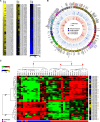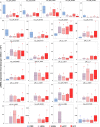Specific patterns of PIWI-interacting small noncoding RNA expression in dysplastic liver nodules and hepatocellular carcinoma
- PMID: 27429044
- PMCID: PMC5342370
- DOI: 10.18632/oncotarget.10567
Specific patterns of PIWI-interacting small noncoding RNA expression in dysplastic liver nodules and hepatocellular carcinoma
Abstract
Hepatocellular carcinoma (HCC) is the result of a stepwise process, often beginning with development within a cirrhotic liver of premalignant lesions, morphologically characterized by low- (LGDN) and high-grade (HGDN) dysplastic nodules. PIWI-interacting RNAs (piRNAs) are small noncoding RNAs (sncRNAs), 23-35 nucleotide-long, exerting epigenetic and post-transcriptional regulation of gene expression. Recently the PIWI-piRNA pathway, best characterized in germline cells, has been identified also in somatic tissues, including stem and cancer cells, where it influences key cellular processes.Small RNA sequencing was applied to search for liver piRNAs and to profile their expression patterns in cirrhotic nodules (CNs), LGDN, HGDN, early HCC and progressed HCC (pHCC), analyzing 55 samples (14 CN, 9 LGDN, 6 HGDN, 6 eHCC and 20 pHCC) from 17 patients, aiming at identifying possible relationships between these sncRNAs and liver carcinogenesis. We identified a 125 piRNA expression signature that characterize HCC from matched CNs, correlating also to microvascular invasion in HCC. Functional analysis of the predicted RNA targets of deregulated piRNAs indicates that these can target key signaling pathways involved in hepatocarcinogenesis and HCC progression, thereby affecting their activity. Interestingly, 24 piRNAs showed specific expression patterns in dysplastic nodules, respect to cirrhotic liver and/or pHCC.The results demonstrate that the PIWI-piRNA pathway is active in human liver, where it represents a new player in the molecular events that characterize hepatocarcinogenesis, from early stages to pHCC. Furthermore, they suggest that piRNAs might be new disease biomarkers, useful for differential diagnosis of dysplastic and neoplastic liver lesions.
Keywords: hepatocarcinogenesis; hepatocellular carcinoma; piRNAs; small non-coding RNA; smallRNA-seq.
Conflict of interest statement
The authors declare no conflicts of interests.
Figures




Similar articles
-
Non-coding RNAs in Various Stages of Liver Disease Leading to Hepatocellular Carcinoma: Differential Expression of miRNAs, piRNAs, lncRNAs, circRNAs, and sno/mt-RNAs.Sci Rep. 2018 May 22;8(1):7967. doi: 10.1038/s41598-018-26360-1. Sci Rep. 2018. PMID: 29789629 Free PMC article.
-
Dynamics of Genomic, Epigenomic, and Transcriptomic Aberrations during Stepwise Hepatocarcinogenesis.Cancer Res. 2019 Nov 1;79(21):5500-5512. doi: 10.1158/0008-5472.CAN-19-0991. Epub 2019 Sep 10. Cancer Res. 2019. PMID: 31506333
-
The expression of transforming growth factor-alpha in cirrhosis, dysplastic nodules, and hepatocellular carcinoma: an immunohistochemical study of 70 cases.Am J Surg Pathol. 2007 May;31(5):681-9. doi: 10.1097/PAS.0b013e31802ff7aa. Am J Surg Pathol. 2007. PMID: 17460450
-
Latest developments in precancerous lesions of hepatocellular carcinoma.World J Gastroenterol. 2016 Mar 28;22(12):3305-14. doi: 10.3748/wjg.v22.i12.3305. World J Gastroenterol. 2016. PMID: 27022212 Free PMC article. Review.
-
Long noncoding RNAs: Novel insights into hepatocelluar carcinoma.Cancer Lett. 2014 Mar 1;344(1):20-27. doi: 10.1016/j.canlet.2013.10.021. Epub 2013 Oct 30. Cancer Lett. 2014. PMID: 24183851 Review.
Cited by
-
Current Achievements and Applications of Transcriptomics in Personalized Cancer Medicine.Int J Mol Sci. 2021 Jan 31;22(3):1422. doi: 10.3390/ijms22031422. Int J Mol Sci. 2021. PMID: 33572595 Free PMC article. Review.
-
Elevated expression patterns of P-element Induced Wimpy Testis (PIWI) transcripts are potential candidate markers for Hepatocellular Carcinoma.Cancer Biomark. 2024;39(2):95-111. doi: 10.3233/CBM-230134. Cancer Biomark. 2024. PMID: 38043006 Free PMC article.
-
PIWI-interacting RNAs and PIWI proteins in glioma: molecular pathogenesis and role as biomarkers.Cell Commun Signal. 2020 Oct 27;18(1):168. doi: 10.1186/s12964-020-00657-z. Cell Commun Signal. 2020. PMID: 33109195 Free PMC article. Review.
-
The emerging role of the piRNA/piwi complex in cancer.Mol Cancer. 2019 Aug 9;18(1):123. doi: 10.1186/s12943-019-1052-9. Mol Cancer. 2019. PMID: 31399034 Free PMC article. Review.
-
Epigenetic remodelling in human hepatocellular carcinoma.J Exp Clin Cancer Res. 2022 Mar 24;41(1):107. doi: 10.1186/s13046-022-02297-2. J Exp Clin Cancer Res. 2022. PMID: 35331312 Free PMC article. Review.
References
-
- Ferlay J, Shin HR, Bray F, Forman D, Mathers C, Parkin DM. Estimates of worldwide burden of cancer in 2008: GLOBOCAN 2008. Int J Cancer. 2010;127:2893–2917. - PubMed
-
- Forner A, Llovet JM, Bruix J. Hepatocellular carcinoma. Lancet. 2012;379:1245–1255. - PubMed
-
- Nault JC, Calderaro J, Di Tommaso L, Balabaud C, Zafrani ES, Bioulac-Sage P, Roncalli M, Zucman-Rossi J. Telomerase reverse transcriptase promoter mutation is an early somatic genetic alteration in the transformation of premalignant nodules in hepatocellular carcinoma on cirrhosis. Hepatology. 2014;60:1983–1992. - PubMed
-
- Whittaker S, Marais R, Zhu AX. The role of signaling pathways in the development and treatment of hepatocellular carcinoma. Oncogene. 2010;29:4989–5005. - PubMed
MeSH terms
Substances
LinkOut - more resources
Full Text Sources
Other Literature Sources
Medical

